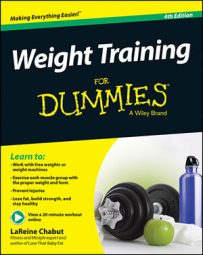Some people thrive on one-on-one instruction. Others really respond to the atmosphere of a class, even if they can afford a private trainer. If you’re uncomfortable with someone scrutinizing your every move, as a personal trainer does, then taking a class is a good way for you to discover weight-training techniques while still blending into the crowd.
And if you’re short on self-motivation, your classmates hold you accountable and keep you pumping weights when you’d prefer to go home and watch TV. Even if you’re the type of person who enjoys working out alone, you can pick up new moves by taking an occasional class.
Conditioning your muscles
Some buzzwords for weight-training workouts include circuit training, interval training, muscle conditioning, body sculpting, and body shaping. Teachers probably started these terms because they figured weight training would scare away people who’re afraid of lifting weights.
Group classes use dumbbells and exercise bands, as opposed to weight machines. A class typically lasts between 45 and 60 minutes and works all the major muscle groups in the body. Most clubs also offer 20- to 30-minute classes, such as “Abs Only” or “Lower Back Care,” that focus on particular areas of the body. If you take a focused class, just make sure that you don’t neglect the rest of your body.
Two flaws that commonly plague these classes are performing too many repetitions and failing to use enough weight. Just because you’re in a classroom doesn’t mean that the basic rules of weight training go out the window. You still need to lift enough weight for each exercise so that the muscle in question is fatigued by the 15th repetition.
Getting quality group instruction
In general, the quality of instruction has drastically improved in recent years, because most clubs demand certification and because poorly attended classes get dropped from the schedule. If you don’t like one instructor, try another one if your schedule permits.
Look for the following when evaluating an instructor:
Certification: The American College of Sports Medicine, the American Council on Exercise, or another nationally recognized organization should certify your teacher as an exercise instructor. Instructor certifications are different from personal-training certifications.
Typically, the exams aren’t as difficult in the areas of fitness assessment and individual program design as they are for personal trainers, but the tests focus more on the skills that instructors need for group training situations.
Concern for newcomers: A good instructor asks whether anyone is new to the class and whether anyone has any injuries or special problems. If you fill the bill, you may want to arrive a few minutes early and explain your situation to the instructor. She may give you a special place to stand so she can keep an eye on you. At the very least, you should get a little extra attention.
Clear instructions: A good instructor acquaints you with important terminology without overloading you with jargon.
Concern for safety: Don’t be afraid to walk out of any class that doesn’t feel right. Don’t worry about hurting the teacher’s feelings. Your priority is keeping your body intact.
Motivation: Instructors shouldn’t act like they’re on autopilot. Your instructor should be one of the reasons that you look forward to going to class and someone who keeps you interested in your training program. The teacher should model correct form and demonstrate a variety of options for people of different levels in the class. Your responsibility is to choose the correct level. If you’re not sure which level that is, ask the instructor.
Individual technique tips: Instructors can’t possibly give a personal-training session to all 20 members of the class, but they should offer some individual tips. They need to let you know if you hold your arms too wide during chest-fly exercises or if you throw your body around when you do biceps curls.
If you have questions about any exercises, take the initiative and come to class a few minutes early or speak to the instructor after class. Be courteous. If your instructor is busy that day, ask when a convenient time for you to ask a question is.
A warm-up, cool-down, and relaxation stretch: Every weight-training class should have a warm-up that consists of at least six minutes of light aerobic exercise to warm up muscles and joints. The class should end with three to five minutes of light movement at a lower intensity to cool down, followed by a five- to ten-minute stretching and relaxation segment.
Take advantage of the instructor-led relaxation and stretches. Focus on deep breathing, releasing muscular tension, and achieving a good stretch. So often, people skip this part of training. More and more evidence from research supports the importance of learning how to relax to improve health and well-being. Enjoy these few moments to relax both your body and mind.
An intensity check: During the class, the instructor should check to make sure that people aren’t pushing themselves too hard (or taking it too easy to benefit from the workout). The intensity check can be something as casual as “Hey, how’s everyone doing so far?”

